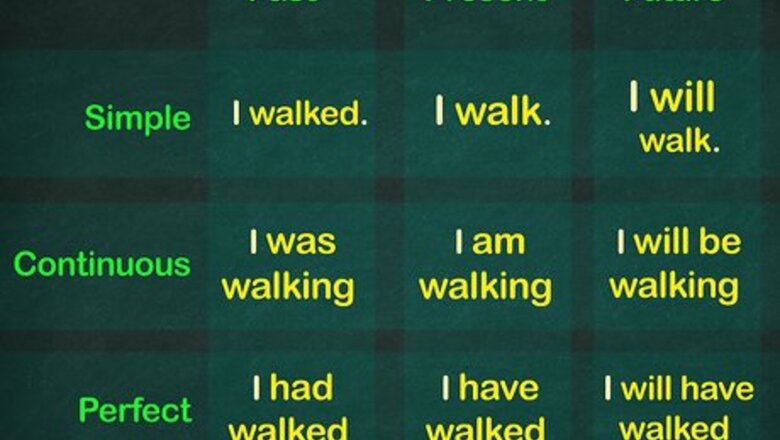
views
- Focus on a single time frame at a time, like the present, to make things easier.
- Review the tenses in that time frame and how they relate to each other.
- Let students practice using the tenses in each time frame with activities and games.
Teaching the Time Frames

Provide a quick overview of the entire system of tenses. Draw a grid on the board, for instance, that identifies all the tenses you'll be teaching. To focus on the 9 basic tenses, for instance, write “Past,” “Present,” and “Future” along the top of the grid, “Simple,” “Continuous” (aka “Progressive”), and “Perfect,” along the side, and fill in the 9 grid boxes with examples from a single verb (e.g., saw, see, will see, etc.). There are more than 9 verb tenses in English--some experts say 13, which includes “perfect continuous” as its own tense and “future with 'going to'” as its own category. Others claim there are actually 16 tenses, which includes “perfect progressive” and “conditional” tenses, but starting with the basic 9 is good for an introductory or ESL setting. In a more advanced class, you can also use a grid to introduce 16 verb tenses.
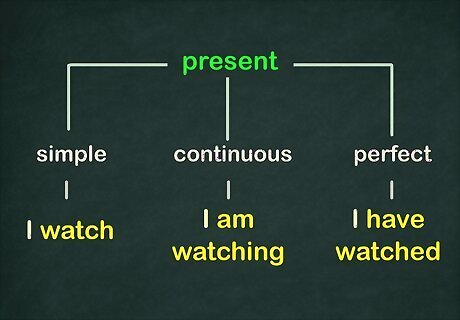
Focus on a single time frame, such as the present. After identifying the entire system, narrow your focus to 1 of the 3 time frames. The present time frame makes a good starting point, since it is often the easiest for students to immediately comprehend. For example: I watch (simple), I am watching (continuous), I have watched (perfect). This runs counter to methods that focus, for example, on the simple past, simple present, and simple future at once (e.g., watched, watch, will watch). The reasoning behind this is the assumption that students are better able to follow along when you stay in a single time frame. After all, when you tell a story, you tend to stay in the same time frame throughout.
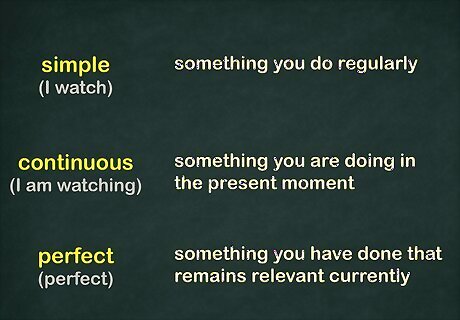
Discuss the tenses within that time frame in relation to each other. Describe the similarities and differences among “eat,” “am eating,” and “have eaten,” for example. All 3 refer to something that continues to be true in the present moment, but each presents distinct information. “Eat” indicates something you do regularly across time frames. “Am eating” indicates something you are doing in the present moment. “Have eaten” indicates something you have done that remains relevant currently.

Incorporate frequent reviews as you move onto the other 2 time frames. As you advance from one time frame to the next, make sure to circle back regularly to review previously-covered time frames and tenses. This reinforces the connections across time frames. For example, if you're discussing “will walk,” “will be walking,” and “will have walked” in the future time frame, related these to “walk,” “am walking,” and “have walked” in the present.
Timeline for ESL Students
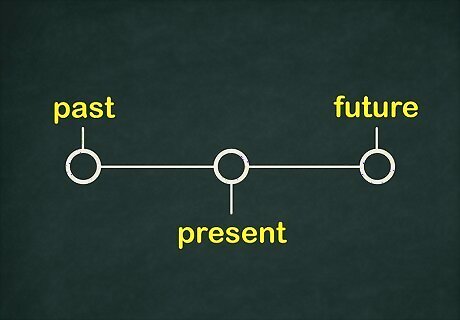
Begin with a timeline that emphasizes past, present, and future. ESL (English as a second language) students often struggle with English verb tenses because many other languages don't use so many different tenses. To make the process less daunting, draw a simple timeline labeled only “past,” “present” (or “now”), and “future.” No matter their native language background, your students will be familiar with placing and describing actions in the past, present, or future. While particularly useful for ESL students, this timeline approach can also help native English speakers grasp verb tenses more quickly.

Reinforce that all English tenses fit into 1 of these 3 time frames. Any action you describe--like eating, playing, or thinking--must fit into 1 of 3 time frames: now, before now, or after now. Explain to your students that even English, with its large number of verb tenses, follows this simple truth. After that, start introducing specific tenses along the timeline. You might say something like: “You all know I like to drink coffee. Well, I can drink coffee now, before now, or after now.”
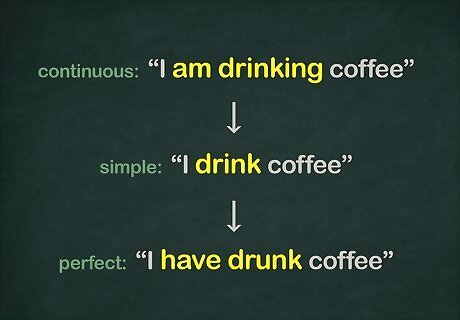
Introduce the present continuous tense first, then the present simple. For most students, the present continuous tense (“I am drinking coffee”) is the most intuitive verb tense. Since it refers to an action happening at the present instant (“are learning,” “is listening,” etc.), students tend to grasp it quickly. The present simple (“I drink coffee,” “You listen to my lectures,” etc.) is also fairly intuitive and can be the second verb tense you introduce. As you introduce verb tenses, locate them along your past-present-future timeline.
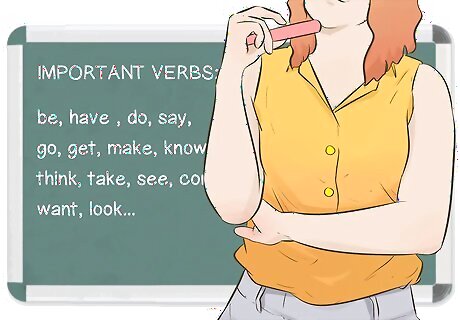
Determine which tenses must be mastered, and which require only proficiency. While it's ideal for any student to master all of the English verb tenses, some are more vital than others for everyday language proficiency. Introduce every tense, but prioritize those that will be most beneficial for your students, ESL or otherwise. ESL students should master the present continuous, present simple, perfect continuous, past simple, and future simple tenses. They should be proficient with the future continuous, present perfect, and present perfect continuous tenses.
Activities and Games

Go back and forth with your students, providing interesting examples. Personalize the learning experience by drawing from familiar examples in your life, then ask the students to draw from their own lives in turn. This helps the students connect the verb tenses you're introducing to the ways they already think about and use language in their everyday lives. For instance: “I drove to work this morning. In fact, I drive to work every school morning. Can you name some things you did this morning, and things you do every morning?” Along the way, point out how they're using different verb tenses, often without even realizing it.
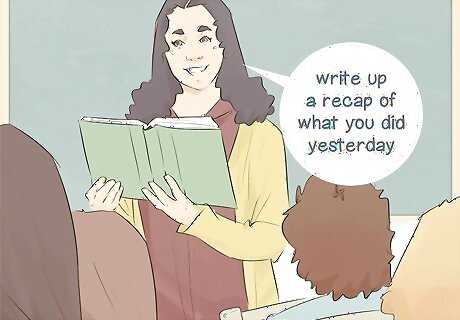
Provide authentic opportunities to practice verb tenses. In this case, authenticity means relevant and personalized, rather than abstract and disconnected. Have your students write up a recap of what they did yesterday, or create a schedule for what they'll do tomorrow. Ask them to give directions to their home, favorite restaurant, etc. Let's face it—verb tenses can seem like pretty dull subject matter. Anything you can do to connect them to the lives and experiences of your students will help.

Play group games to help identify specific verb tenses. Gathering your class together as a group to play a familiar game can make learning verb tenses easier and more fun. Also, certain games are particularly useful in teaching certain aspects of verb tenses. For example: Charades helps with the present perfect tense: “He is walking a dog!” or “They are playing tennis!” “Mother May I” is useful for helping verbs like may, could, and should: “Mother may I…,” “Yes, you may…” (substitute “can” and “should” as desired).

Use storyboards to help practice past tenses. Create a storyboard by drawing or cutting out several pictures that, when combined, tell a simple story. Jumble up the pictures and attach them to the board. Have you students put the story back in the proper order, but require them to tell you what happened both before and after each picture they want to move. The game becomes even more of a learning experience (and fun!) if the pictures can be arranged in different ways to tell different stories. Get creative in making up your storyboard!
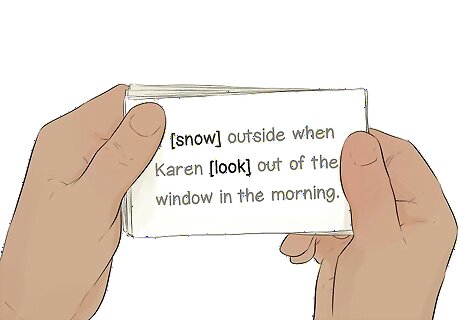
Make narrative story cards for your students to complete and arrange. Make up a narrative story that is described in 16 sentences. Type each sentence onto a card and cut it out. On the other side of the card, use the same sentence, but don't provide the correct verb tense. Your students can first arrange the story cards in the proper order, then play using the tense-free side of the cards and provide the proper verb tenses. For instance, one side of the card might say: “It was snowing outside when Karen looked out of the window in the morning.” The other side might say: “It [snow] outside when Karen [look] out of the window in the morning.” You can find templates for this type of game online—for instance, at https://mikeastbury.files.wordpress.com/2017/05/narrative-tenses-cards.pdf



















Comments
0 comment